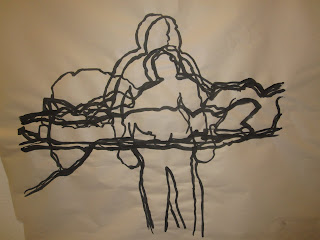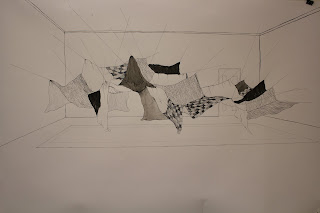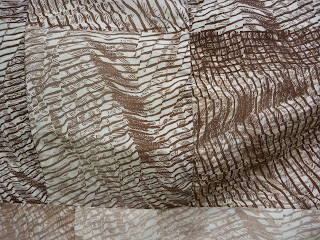Response to Critique:
Hi guys,
Before diving into everything I have to say I want to talk about my intensions in writing all of this. The purpose of this post is to discuss what I want my thesis work to potentially be about and what I do not want the work to be about and why. For the sake of my argument for the ideas I do and do not wish to delve into I am using my experiences and experiences parallel to my own as a source for my material in this work—“I should not talk so much about myself if there where anybody else whom I knew as well.” Thoreau, from “Economy” in Walden. The work I plan to make should both educate an audience in ideas of identity (through a lens of a gay identity) as an act of the construction of oneself, as well as emphasize the striking similarity between us all, in which we all assert our identity through daily actions—“It seemed to her such nonsense – inventing differences, when people, heaven knows, were different enough without that.” Virginia Wolfe, To the Lighthouse.
The first section focuses solely on my thoughts and concepts I plan to tackle. The Second section focuses on the formal artwork I plan to create. The third section addresses why I think it is important to put this work out into the world. The fourth section talks about the work that I am not making, and for this project do not wish to make.
1. Performativity
In elementary school I didn’t make calls and I didn’t receive calls—everything was planned out for me. But I made sure to answer the phone when it was an unknown number. Sometimes it was a telemarketer. I’d answer—“hello?” They’d say Mrs. Greenberg, could I please speak to your husband—“I’m sorry he’s not available.” My voice was high pitched. Distinctly feminine.
Judith Butler formed the concept of performativity in 1990 in regard to gender. To Butler, gender performativity is reiterated acting producing the effect of a static gender, while obscuring contradiction. Thus, it had to do with passing as one’s desired gender. Misreadings of her concept of performativity led her to publish Bodies That Matter in 1993. Here Butler spends time noting the significance of iterability, or a regularized and constrained repetition of norms, within her theory of performativity—“Performance is not a single act or event, but a ritualized production.” Thus performativity describes a process of discursive production.
I cannot tell you how many times I’ve been asked, “Can I ask you a personal question?” “The answer is yes. Yes, I’m gay.”
What I am interested in talking about in my work is a little bit different than performativity, but certainly related. As a gay male I’ve had to pass at times as a straight male and also as a gay male. Unlike ideas of performativity, which encapsulates an entire process and gender regime, I am interested in the specific performance—the specific instance in which a conscious decision for passing is made.
I heard the word fag, queer, and gay all of the time. For a long time I didn’t know what these words meant, other than it was the same as calling someone a girl. I certainly didn’t know that I could be a fag—I had boy parts. But there was a gay test. Ask the suspect to look at his fingernails. If he curls his hand halfway into a fist than he is not gay. If he spreads his hand out in front of him than he is gay. My instinct was to curl my fingers.
And the specific moment in which we construct ourselves.
I went to an academic summer program where I met other gay people my age for the first time. They all convinced me that the only way to be happy would be to meet other gay guys online. I created a myspace page at fifteen. There was a special feature where I could search for local guys in my age group with the same sexual orientation. They all had fantastic pictures with spiked hair, fabulous lighting, or bare-chests. The next year I enrolled in a photography class. So much time that year was devoted to taking the perfect image of myself.
II. The Work
With two primary bodies of work, the works will transition by sharing similar formal elements and will be in dialogue with one another. The implementation of descriptive text and titles will focus the content of the work. Essentially, my objective is to resolve the issues apparent in my last critique (the difficulty for the viewer to enter the content/context of the work and a problematic use of physical materials.)
A. The Test, The Self, The Smother Affect
The gay test—it was just mentioned—how do you look at your fingernals?
I plan to draw my hand in the two positions. Like the drawing of my palm print I plan to do the drawings at a larger size (tracing the naturally occurring lines in my hand), and then reduce them to life size, the actual size of my hands. Between the two images there will be text explaining the gay test. The text will be in light red. The drawings will be in black.
Alongside this work there will be two other works—another diptych and a sculpture component.
The diptych will be the woodcut of the back of a shirt printed in black and the photographic image of the front of the shirt printed out on the same paper as the woodcut and traced in red pen in the center of the image where the shirt gathers.
The sculpture component will be my palm print blown up to the size of a full sized bed sheet, and printed as a sheet. The bed sheet will be stiffened in order to have a similar bulbous quality that the photographic image of the shirt has. This component will be presented on the floor. Additionally, selective, significant lines occurring on the palm of my hand will be traced in red.
The notion is that my hand depicted in the two positions is a meditation of the childhood test of sexuality. The photographic component represents a specific individual, an ad almost, a specific presentation. It is wet, raw, and about a body. The image of the woodcut is from behind. It is nonspecific. It could be anyone. It incorporates the same line quality as the sculpture component on the floor. They both talk about identity. A shirt is something one can take on and off though. A palm is permanent fixture. There is a bulbous form both in the photographic image and the sculpture component of the palm.
B. The Construction
The section will consist of images I have gathered from myspace and facebook (of some people who I know and some who I do not) depicting images in which a gay identity is asserted and constructed. These will be engravings on flat sheets of glass with red ink wiped into the engraving. The flat side of the glass will face outward. The engravings of these images will be line drawings—perfect and simple. Ideally these images will be produced to life size and in mass quantity. These images will be paired with text about the construction of self through these pictures. The text will be in red.
These images are also self-constructed in the sense of “selling oneself.” They are like ads.
III. Context
There is an undeniable self-indulgent quality viewers will see in this work. I can’t avoid this. There is certainly a therapeutic element in creating this work as well. However, if this work is for myself and myself only than I have failed the potential of the work. I really do not enjoy talking about myself, I much prefer talking with and about others. What I do enjoy is sharing ideas. The work is about sharing my specific experiences as well as similar shared experiences in order to make the viewer understand and pontificate the notion of having to construct oneself, and that perhaps they already do so (or have done so). Here it is through a lens of gay identity, because this is what I am most knowledgeable in from personal experience.
IV. What the Work is Not About
A. I do not want the work to be about gay sex nor do I want to make work about gay sex and this is why:
People are wrong to imagine teenage boys want to shoot their loads; what they want is a union of souls, which will only incidentally result in a tangling of arms, thighs, loins. Teenagers do not fetishize big cocks, hairy chests, powerful biceps, or blond hair and thick necks; their desire is too general to respond to anything less than eternal love and their love is vague and powerful enough to ennoble any body at all.
-Merla, Patrick, Boys Like Us
There is a very silly notion that a gay identity is about sex. That gender and sex are the same thing. That when making any sort of gay art that there is some element of sex. In truth gay and straight sexuality is only different in the technicalities. What makes me different from a straight person is not my emotional and physical attraction to men. What makes me different than a straight person is that I have to claim and perform my identity in a specific way—granted some straight men feel they too have to claim and perform a socially acceptable masculine identity.
B. I do not want this work to be a historical overview of gay rights:
All history is current; all injustice continues on some level somewhere in the world.
-Walker, Alice, The World Has Changed
I put this quote here first to emphasize that history does matter (Alice Walker built her career off of this notion.) In order to understand ourselves, we must understand our past. Without our past we are nothing. This is certainly true when it comes to gay rights—not until 1973 was homosexuality removed from the Diagnostic and Statistical Manual of Mental Disorders, largely due to protests. A historical approach to sexuality and gay rights is certainly a rich territory to explore, as well as a territory surprisingly few people know about—no one in my immediate family knew what the Stonewall Riots were. However, I simply do not want to delve into this territory for this specific body of work. I want to limit my subject to issues of performativity and a construction of the self.
C. I do not want to use the language of a type:
I have to clarify a little bit here. A few times I have been given advice that I could find a visual metaphor to describe a type of gay people. Once I was given advice that I could depict anuses as miens of a metaphor for gay men. The works on glass I plan to create describe a ritual that is meant to assert a specific gay identity, but also serve as an advertisement as oneself (not a type, as in the same.) The idea of a type in such a straightforward manner would undermine what I am trying to do here. I am trying to talk about performativity and the construction of oneself. The idea of a type is pretty bogus and seems to just perpetuate the same problematic ideas we have about the differences in individuals as of now.













 Candice Smith Corby -
Candice Smith Corby - 













